
•Very light, appears as if he is dangling, proportions are incredibly elongated, no background, gold flat background, little pictures with stories of the life of St Francis
•No sense of depth, stylized, very flat and elongated, without weight
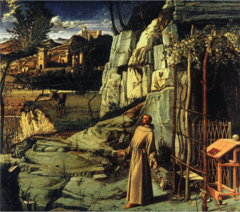
•Much more naturalistic, creates setting with animals creatures, can
•There is a lot of depth, clouds, highly naturalistic, believable space
•Figure is correctly proportioned and conveys a sense of weight and gravity, perfectly at home within the three dimensional space
•Dramatic space

• She is strangely flat, very elongated, little head very long body (Christ)
• Angels surrounded show no correct use of space
• Halos lay on a flat surface, golden background,

•Much more naturalistic
•Much more depth, rolling hills, a lake, a forest, blue grey mountains on the horizon
•Colors change due to imposition of atmosphere
•Madonna has a very comfortable pose, seems real and natural, caressing her child, keeping her upright
•Arranged ina pyramid form: characteristic of Rennaisance art
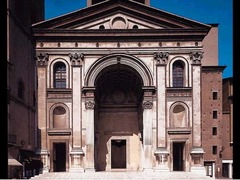
Sant’ Andrea, Mantua. Beg. 1472. Early Renaissance.
Early Rennaisance
-Alberti locked two complete ancient Roman architectural motifs- the temple front and the triumphal arch.
-the familiar combination was already a feature in early Roman architecture
-e/g many triumphal arches incorporated a pediment at the top over the corinthian columns, but this design is much more eclectic
-he equalized the vertical and horizontal dimensions on the facade
•Divided into three parts, great arch in the center, very organized and simple
•Topped with triangular pediment and decorated elemnts are clearly delineated
•Corinthian capitals, reminds of antiquity
•Inspired by arch of Constantine, in 15th century provide inspiration for Rennaisance architects
•Corinthian ordered columns, triumphal arch,
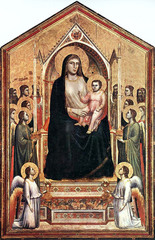
•Served as altar pieces in religious age
•Figures are not as flat, sense of proportion have air around them,
•Sense of space by the way she turns slightly
•Faces have light and shadow on them so they have a tendency to be modeled or made round
•Drapery seems more realistic has real holes in it and movement
•The Cimabue Madonna seems more like a stylized pattern
•Giotto is modeling the drapery more,
•The figures are overlapping one another so you can believe they are
•Creates a space box around her that gives the Madonna a space that she is under, gives illusion of airand space within the picture
-a founder of Renaissance art and direct descendent of Cimabue
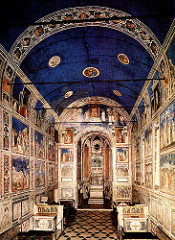
Italian Gothic
•Religious subjects, the end wall behind the altar, the last judgement,
•Panels cover the walls , lowest part with images from the old and new testament
•Frescoe technique: painting on wet plaster with water colors that are absorbed into the plaster wall when the plaster dries
•important technique for Italian artists

Lamentation over the Body of Christ
Interior of the Arena Chapel, Padua c. 1305
Italian Gothic
oVirgin Mary mourning over the body of Christ
oEmotion presented through body languages, gestures themselves shows the sadness
oAcute observer of nature, knows the emotions of human being, weeping whaling
oBright colors in frescoes often

Chapel, Padua c. 1305 Italian Gothic
oRoman soldiers are capturing Christ
oSimple nature of robe, very much like antique sculptures
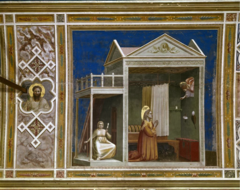
Annunciation to St. Anne.
Interior of the Arena Chapel, Padua c. 1305
Italian Gothic
oWings are stuck, blessing St. Anne, outside space there is woman holding yarn spindle thingy
oCreates a very believeable three dimensional space, space box, placing figures within have a great sense of weight
oLegs are arranged so you can see her lap
oDrapery helps understand the body
oWithin a naturalistic space, bodies turn slightly towards us
oGive depth, Giotto very early for depth like this
oInspires Rennaisacne about 100 years later
Similar to to netherlands, as it has a lot of political subdivisions. Lots of competition and rivalries
he made several trips to Rome to study Roman monuments, his close study of them allowed him to accurately record a geometric system of linear perspective

-where as Brunelschi imbued the image with romantic emotion, Ghiberti emphasized grace and smoothness, Abrahamappears in a typically Gothic pose with outthrust hip and seems to contemplate the act he is about to perform, even as he draws the knife back.
-The figure of Isaac, beautiful posed and rendered, recalls antiquity/Grec-Roman influence and could be regarded as the first classical nude since antiquity
-Ghiberti shows interest in the human muscular and skeletal system, even the altar he sits on recalls antiquity
-these classical references reflect the increasing influence of humanism in the 15th century.
-also shows the artist’s interest in spatial illusion. The rock landscape seems o emerge from the blank panel toward the viewer, as does the strongly foreshortened angel.
-Ghiberti cast his panel in only two piece, less bronze needed, impressing the committee, thus his doors would be lighter and more impervious
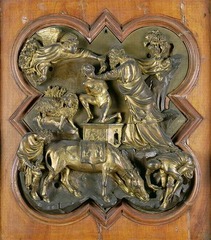
–Brunellschi’s entry into the competition to create the new bronze door of the Florentine baptistery facing the Florence cathedral shows a frantic angel about to halt an emotional, lunging Abraham clothed in swirling
-THe angel matches Abraham’s energy as he lunges forward
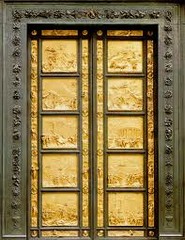
-In 1425 the church officials of Florence commissioned Ghiberti to do the east doors of the Florentine Baptistery,
-Each panel contains a relief set in plain molding and depicts a scene from the Old Testament.
–Ghiberti achieved a greater sense of depth than his previous reliefs
-he maintained the medieval method of representing several narratives in a single frame
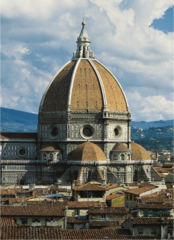
-created a pointed arch to solve the problem of a not so wide crossing of the Florence Cathedral, to minimize the structure’s weight, he designed a thin double shell,
-does not truly express his renaissance style
-decided to propose to build the dome
-a double dome: outer skin and inner skin with a set of ribs, self-supporting eerie soy ribs that go up to the to top
-used a herringbone brick pattern to build the outer dome, interlocking of designs on the surface, makes the dome much more sturdy
-invented elevator that brought men up the top, took 15 years to contract, dome is slightly elongated, almost pointed like in the gothic structure, just because it was new in engineering
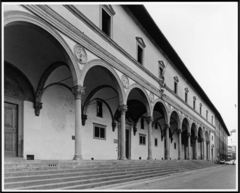
-based on the idea of ancient art, but a little bit lighter, elegant columns, corinthian capitals on the columns, rounded arches, above thea riches architrave that looks like architrave on a classical building
-second story is series of windows toped with triangular pediments
-the porch, proportioned in a way that is very clear, squares and cubes, width of porch is very same as the height up to the capital evoking and scare cross section
-infant (function of the building) orphanage
-corinthian capital
-very regular, temple form, regularity of an ancient building, each unit of the building is identical,
-building dimensions are very rational (unlike gothic which is extremely irrational)
-other side of the cathedral, another commission he received
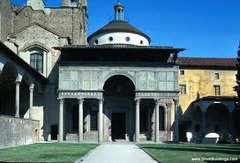
-Show Brunelleschi’s interest in early central plans of antiquity such as the Roman Pantheon
-was commissioned by the Pazzi family and was a gift to the Franciscan church,
-its domed, with a very clear colonnade,support large rounded arch in the center, facade is based on small numbers, height of colonnade is equal to the hight above it
-it is one of the first independent Renaissance central plan buildings, served as the monk’s chapter house
-edge of square is right down the middle
-ground plan is based on squares and circles
-rational architecture
circle which represents dome above which is inscribed in a square
-semi-circles at the end, the altar is the equivalent
-dome seems weightless with oculus in the middle, circular window around the dome, 12 of them, symbolic reference to christ and his 12 decipals
-uses ancient architeural forms
-spaces are divided in a way that one space is twice as big as other
-relationship between forms, based on small whole numbers, clear relationship of sizes of these arch forms
-ancient Roman architecture studied it, looked at surviving buildings, academic aspect to this
-consciously trying to revive the secrets of antiquity

-family shape would be paid fully by the Broncocci family
– done in fresco (looks differently from oil) paint applied to a wet plaster surface, paint is essentially a watercolor, pigments are brown but in water they are applied and as plaster dries it absorbs the pigment and image becomes part of the wall itself
-frescos are very long lived in warm weather, the north is too damp
-very brightly colored (frescos) a lot of pigment in the water/ in the liquid plaster thats in the water
-the difference between oil (takes long time to dry) fresco dries really quick (so can’t work over long period of time)
-once fresco dries can no longer absorb the color, have to work in small area

-Commissioned by the Brancacci family for their family Brancacci cheap in Florence
-This is placed in an awkwardly narrow space
-the sharply slanted light from an outside source creates deep relief, with lights placed alongside darks to create three dimensionality
-they stumble on blindly, expelled from the Garden of Eden
–Adam and Eve on left hand corner, archangel michael is escorting them
-figures are a little less details, shadows are sharper on Adam, not blended as well,
-Renaissance art is different than northern (more stoic), Italian know their emotions and infuse them into their paintings, Eve and Adam, his face implies sham Eve seems like she is in agony
-her head is thrown back mouth is open, covers herself (in shame)
-body language and facial expressions are more exaggerated than in north but less naturalistic with shape because fresco was harder
-From the Ghent altar piece comparison: much more detailed, flesh like detail, hair is brassily, much more detail due to oil paint, but hardly any emotion on the faces, fairly stoic
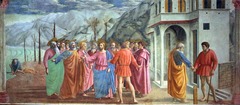
-Comissioned by the Brancacci family for the Brancacci family shape of Santa Maria del Carmine in Florence
-Christ direct St. Peter to the shore of Lake Galilee, there as Christ foresaw, Peter finds the tribute coin in the mouth of a fish and returns to pay the tax.
-Tribute Money could be a commentary on the income tax that Florentines were considering implementing at the time
-was in a private family chapel, so public did not have access,
-Masaccio decided to divide the episodes into three separate area. In the center, Christ and his disciples, tells Saint Peter to rerieve coin, at left, St. Peter finds coin rom fish’s mouth.
– at the right, he thrust the coin into the tax collectors hands
_Massacio’s figures recall GIotto’s in the simple grandeur, but they convey a greater psychological and physical credibility
-he created a sculptural weight to the figures using light and shadows,
-they move freely and reveal body structure beneath their heavy fabric clothes, they are not stiff screen, instead groups them in circular depth surrounding CHrist
-vanishing point is found where the orthogonals converge at Christ’s head,
-Atmospheric perspective is also used,-Painted shortly before his death, Masaccio depicts a seldom represented theme from the Gospel of Matthew
-a tax collector confronts Christ at the entrancef a Roman town and Christ
-Christ in the center is telling St. Peter to pay the tax collector
-Peter obeying Christ in front of the other desipals, taking the coin form the mouth of the fish
pays the tax man (three part)
-single figure represented more than once in a narrative context in parts of the image (simultaneous representation)
-Christ telling Peter to do this (central part of narrative)
-correct human proportions , uses linear perspective, parallel lines of architecture off to the side, meets are eye off to the distance out into a vanishing point near where the head of Christ is
-figures are heavy, belong in the space the artist provides, have a sense of mass, how do you reveal the body when body is draped, want body and drapery to work together
-St Peter: can identify waist, can see knees
-not much going on in landscape, has to move quickly before it dries
-gernata (days work), artist works very carefully for one day, can see line where plaster joins, worked for one day on Christ(mark the edges of the gernata

-In Santa Maria Novella, is another of the young artist’s masterworks and the premier early 15th century example of the application of amthemativs to the depiction of space.
-Masaccio painted the composition on two levels of unequal height, above in a coffered barrel-vaulted chapel reminiscent of a Roman triumphal arc,the virgin Mary and Saint John appear on either side of the crucified Christ. God the Father emerges from behind Christ, supporting the arms of the cross presenting his Son to the worshiper as a devotional object
-The dove of the holy spirit hovers between God’s head and Christ’s head, Masaccio also included portraits of the donors of the painting, who kneel just in front of the pilasters that frame the chapel’s entrance.
-above skeleton “I was once what you are, and what I am you will beomce.”
adapts Brunellesch’s new science of perspective perfectly. the vanishing point pulls the two views together creating an actual illusion of a structure that trisect the wall’s vertical plane, where as the tomb appears to project forward.
-also is able to represent full bodied figures very easily, bathed in light with the combination of linear perspective
-christ with the two donors,
-constucts a niche, barrel vaulted niche, that you are looking up into from a position in the room, if exactly at the right position, everything looks like it should to create space
-it is a burial site for the donors, has a tomb that is in the floor, there is a painted sarcophagus at the bottom with skeleton on it (with inscription which reads: what you are I once was, what I am, you soon will be)
-reminder of death momentum moreeam
-completely flat on the wall,
-contruction system: the dotted lines represent he orthogonals that were placed on the fresco by snapping string lines (chalked string)
-vanishing point which is at the eye level of the viewer, lines convert at this point (par ell lines converge to create vanishing point)
-all of the lines converge at the same point
-Jan Van Eyk did a approximation: actually has three different vanishing points, actually inconsistent, Italians focused on this

February.
Tres Riches Heures of the Duke of Berry. c. 1413-16 (Chantilly, France)
Early Netherlandish
-Limbourg brothers produced this prayer book for the brother of the Duke of Berry
-numerous full page illuminations (the picture is ‘light’ within the book)
-brilliantly decorate the interiors of these books
-close to 200 illuminations inside
-calendar is at toop of page (january at left and February on other side)
-signs of zodiac that are marching across the top of pages
-calendars were a way of keeping track of religious peace days
-Duke’s court: he is seated behind the table, talking to well dressed individuals, servants, hanging on wall behind fireplace is a tapestry of on of the
-very indulgent duke , owner of many manuscripts
-the peasant secular page, are strictly about the calendar, secular life scenes related to the calendar
-outside the farmstead where they leave, sheep, birds eating grain
-observation of nature, very much opposes medieval work
-classical reference: image of Apollo, God of the sun is shown moving the calendar from january to february
-but not depicted with classical intent
-looking at classical sources and nature (two things that compel the Rennaisance )

Tres Riches Heures of the Duke of Berry. c. 1413-16 (Chantilly, France)
Early Netherlandish
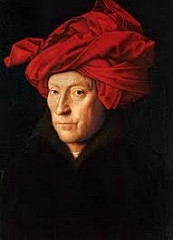
-In the 15th century
-In the 15th century FLemish artists painted secular portraits without the layer of religious interpretation present in the Arnolfini portrait
-The private commissions began to multiply as both artists and patrons became more interested in reality the portraits revealed.
-The man depicted looks directly at the viewer, could be the first Western painting in a thousand years that does so.
-Jan crated illusion that at whichever angle the viewer looks it appears the eyes are in gaze towards them.
Injected a heightened sense of specificity by including beard stubble, veins in the bloodshot left eye, and weathered, aged skin.
-Across the bottom it says “Jan Van Eyck made me”:
-The use of both Greek and Latin suggest the artist’s view of himself as a successor to the fabled painter of antiquity.
-Jan Van Eyck: dutchman from the north, not French, comes from the north
-trained by the north but hired by a French Duke
-also did private commissions
-Jan Van Eyk always dates the frames, added biblical phrases to the frame
-insxription in Greek Letters (classical reference)
-in Greek letters “Jan Van Eyk made me)
-combination of Roman Numerals and arabic ones to sign the date
-gives commemorative birth date
-motto of artist
-judging the age: painted naturalistically: lines and wrinkles on his face
-looking straight out of the picture, deep red dramatic turban on his head, moves in many differnt directions
-turban has lots of direction, but a guy himself just sits right there
-does not give any sense of setting, the head itself that has an almost marble sculpture like form to it. Three dimensional and projects
-almost like haptic composition (touchable and coming out towards you)
-oil is semi-translucent: comes to eye, makes pictures seem to glow, luminosity in oil painting
-slow drying is an advantage: allows artist to blend the colors subtly so you have a creation of shadows in the oil paintign which visually
-mimick the idea of a sculptured work

The Ghent Altarpiece, Northern Renaissance 1432
-The polyptych was commissioned as the centerpiece of the chapel Vyd built in the church originally dedicated to Saint John the Baptist
-The altarpiece reveals a sumptuous, superbly colored painting of humanity’s redemption through Christ
-In the upper register, God the Father, wearing the pope’s triple tiara, with a wordily crown at his feet, and resplendent in a deep-scarlet mantle- presides in majesty. To God’s right is the Virgin, with a crown of 12 stars upon her head. Saint John the Baptist sits to God’s left. To either side is a choir of angels, Adam and Eve appear in the far panels, the inscriptions in the arches above Mary and Saint John extol the Virgin’s virtue and purity and Saint John’s greatness as the forerunner of Christ.
– The inscription above the Lord’s head translates as “This is God, all-powerful in his divine majesty; of all the best, by gentleness of his goddess, the most liberal giver, because of his infinite generosity.”
The entire altarpiece amplifies the central theme of salvation. Even though humans, symbolized by Adam and Eve, are sinful, they will be saved because God, in his infinite love, will sacrifice his own son for his purpose.
-The panels of the lower register extend the symbolism of the upper. The central panel, the community of saints comes from the four corners of the earth through an opulent, flower-spangled landscape. They proceed tower the altar of the lamb and the octagonal fountain of life.
-The lamb symbolized the the sacrificed Son of God, whose heart bleeds into a chalice, while into the fountain spills the “pure river of water of life”. On the right, the 12 apostles and group of martyrs in red robes advance. On the left appear prophets.
-On the lower wings, hermits, pilgrims, knights, and judges approach froth left and right. They symbolize the four cardinal virtues respectively, Temperance, prudence, fortitude, justice.
The altarpiece celebrates the whole Christian cycle from the Fall to the Redemption, presenting the Church triumphant in heavily Jerusalem
-No small detail escapes the painter by using the oil on wood, rendered in shimmering splendor of color.
He captured the soft teture of the hair, the glittering gold or gems, records the exact surface of humans, animals, objects, and landscapes Became the hallmark of Flemish panel painting in the 15th century.
-altarpiece
-Hubert (Jan’s brother) inscription on the outside of frame that identifies the two of them working on it
-dated and dedicated to the church of St. John
-enormous multichanneled picture
– nearly 20 feet wide and 12 feet tall, still in the church where it was intended to be seen
-the interior is painted in oil, very radiant, light is refracting from the oil
-rich greens, red and blues, could only be done in oil paint
-each panel has an image on the other wide
-not clear who did which part
-mostly considered to be Jan
-upper part are large simple figures, sculptural, fill spaces fully
-optical composition, invited to look deep into space, vast sweepign landscape across the panels of the bottom, figures project out towards us (top)
-bottom brings us into distance
-scene of heaven, there is mass going on in this heaven, angels around and saints have gathered in heaven
-belbds oil, gives texture and space within the folds
-figures to his left (john the baptist: first to recognize Christ’s presence on earth)
-to his right is the virgin mary
-on the day this was dedicated Jan something something
-she is reading, jewel trimmed, penetrating
-she is dressed in blue (color of heavens: she is queen of heaven)
-Early netherlandish painting or late gothic (other names)
-change in style from spiritualized somewhat abstract elongated forms, appearance of works of art begin to change due to interest in nature, incorporation of new inspiration
-primarily nature to northerners, have special advantage of oil forms, can create natural looking forms, driers very slowly, can create images that have strong sculptural forms, painter can mimic that natural image of wool, fold, special fabrics, oil paintings literally glow, light refracts
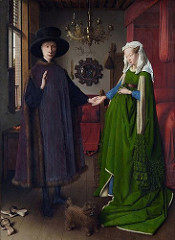
Arnolfini Wedding Portrait. 1434. (London, NG)
Northern Renaissance
-(Book)
-Both the Merode Altarpiece (Campin) and the Ghent Altarpiece contain portraits of their donors, growing tradition and interest in secular art within religious works
-These paintings marked a revival of portraiture, a genre that had disappeared since antiquity,
-The Arnolfini Wedding Portrait is a secular portrait with religious overtones.
-Van Eyck depicted Lucca financier (who had established himself in Bruges as an agent of the Medici family) and his betrothed in a Flemish bedchamber that is simultaneously mundane and charged with the spiritual.
-As in the Merod Altarpiece, almost every object portrayed conveys the meaning of the event, specifically the holiness of the matrimony.
-Arnolfini and his bride, take their marriage
-the cast aside clogs indicate that this event is taking place on holy ground
-the doh symbolized fidelity (Latin word for canine ‘Fido’ meant “to trust”)
-behind the the bedpost’s ornament has a statue pf Saint Margaret, patron saint of childbirth.
-The one lit candle symbolizes the presence of God.
-you can see more in mirror than you can in the picture, very careful understanding of the room, creates a space in the mirror that is even more believeable and revelatory, seeing their backs, and extra set of windows, and in front of the couple are two more people that are not in main picture, one wearing blue and one is wearing red
-Van Eyck’s placement of the two figures convey conventional gender roles- the woman stands near the bed and well into the room, whereas the man stands near the open window, symbolic of the outside world
-Eyck carefully distinguished textures and depicts light from the window on the left reflecting on all various surfaces
-The convex mirro provides more clues into the painting
-the picture’s purpose appears to be to record and sanctify the marriage.
-signed and dated by the artist, within a year or two of Ghent alta piece,
-purely secular image, private commisson the Jan Van Eyk took on from a banker in Bruges
-using natural elements of the visual world as disguised symbols
-posed side by side in a bed chamber, holding hands, her right his left, there is a window and view to the exterior
-convex mirror, little dog (fidelity), Mr. Armolfini’s shoes
-Mrs. Armolfini was age 14, Mr. Armolfini is in mid 30s
-dress is an emerald green, trimmed with fur, blue underdress, luminous folds over her front, holds folds up, gives appearance of being pregnant but suggests the idea of fertality, her function in marriage as child bearer
-Mr Armolfini dressed in very rich dark clothes, trimmed in fur,
-little dog is mediating between the two of them (griffin terrier), stiff fur, can feel with your eyes (oil painting gives ability to mimic textures of all kind of things, glass jewels, doggy fur
-convex mirror (very new things for the time period)
-above mirror is signature above the mirror (Jan Van Eyk) 1434
-“Jan Van Eyk was here,” suggests idea that the artist is not only painting the picture but an official witness to the marriage between the Armolfinis
-nature of the signature, enhances as if it is a visual document of the marriage of the two
-the one lit candle in the chandelier, room is lit with light form window, so why candle??
-relgiious emblem, presence of God in the room, not a relgiious subject but references with candle (suggesting god is blessing the marriage of the Armolfinis)
-small symbols contribute to understanding of the painting, mirror could represent eye of God, present at the scene,
-Dog=Fido= fidelity= elaborates on the idea of fidelity in a wedding picture
-things that are part of natural world, belong to secular bedroom setting, they can have another level of meaning, disguised symbols
-natural things carry secondary level of meaning and enhance the understanding f the picture
-when one takes of their shoes, they are walking a sacred ground, this wedding chamber is in some way a sacred place (small hints)
-composition itself carries meaning: Mr. Armolfini , he is towards the window, the outside world, bring home money
-down the middle things join them together, the candle, the eyes of god, the little dog (fidelity), all lining up to single line in middle of composition
-their worlds joining together-very bright light, makes us occupy the position that the people in mirror are occupying
-could represent Jan Van Eyk himself (frequently does this to get his image into the composition to suggest humility of the artist or signature)
-Red and blue figures
-possibly blessing the marriage
-disguised symbolism= things that are reasonably/rationally there but have a secondary symbolic meaning (often religious meaning)
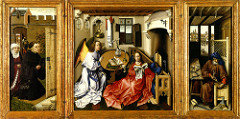
Book: This piece was a private commission for a household prayer, at this time private devotional exercise grew in popularity in Flemish region.
-These images were unique because they featured an integration of both religious and secular concerns. e/g biblical scenes taking place in Flemish houses, the presentation of religious art in a familiar setting (the Flemish house) made the bond the patron or viewer felt with biblical figures
-the popular ‘Annunciation them, occupies the me rod TRIPTYCH’s central plane.
-The archangel Gabriel approaches Mary, who sits reading.
-The artist depicts a well-kept middle-class Flemish home as the site of the event.
-The depicted accessories, furniture, utensils contribute to the identification of the setting as Flemish
-Some function as religious symbols: the book, extinguished candle, and lillies on the table,
-two blossoms open, one just a bud, those three flowers represent holy trinity (father son and the holy spirity) the son is the closed bud
-Campin completely inventoried a carpenter’s shop in order to represent Joseph, the ax, saw, and rod in the not only are tools of the carpenter but also mentioned in Isaiah 10:15
-in the left panel, the closes garden is symbolic of Mary’s purity, and flowers are relate to her humility.
– the altar’s donor and his wife kneel in the garden in witness of the momentous moment, again strengthening the bond of biblical figures with seular life and the Flemish people
-‘Donar portraits’ portraits of the individuals who commissioned the work, became popular in the 15th century.
-Robert Compain (contemporary of Jan Van Eyk)
-Jan Van Eyk works in Bruges
-centerpiece is the annunciation (Angel Gabriel is telling Mary that she is about to bear the Christ child): often firm illuination in a prayer book at the time
-the two wings o Gabriel (most liekly a personal commission), too small to be in altar
-personal devotional picture where a family would personally prayer
-two donors on left hand side of image
-Joseph on right (working at a bench, out the window can see small Flemish town
-center pannel: painted using oils, Angiel Gabriel is just entering the scene, just beginning to kneel, rasing one hand, Mary is still reading her book and has not noticed him, in front of a bench, but not sitting on it
-Throne of Solomon suggestion: little Lions on the arm, bench of the virgin (she is the seed of wisom as Solomon was the great wise ruler like Solomon
-She is not sitting on it, instead sitting on foot rest, suggests her humble humility
-little baby Christ figure riding on the cross, comes through to enter the virgin without distrubing her virginity
-on the table is a wonderful little still life, candle captures an instant when the wick has just been blown out, happened as angel comes in through wind, unseen by the virgin, invisible except to us, his movement creates air the blows out the candle and pushes the smoke towards the bak of the room, moving the pages of the book
-all three elements on the table suggest idea of transition from the old to the new, the old testament to the new testament
-blossom of lillies is about to burst, transition form old form of writing (the scroll) and the book or codex (new form)
-still life is perfectly reasonable as furnishings of the virgins library, but representative of further important symbolic interpretation
-Joseph is a carpenter, working on things, most important object is: a mouse trap: joseph is working on a mouse trap
-Mousetrap, found a reference as Joseph as a mousetrap, symbolic of the theological tradition that Christ is bait set in the trap of the world to catch the Devil.
-Joseph is actually a mousetrap according to medieval literature (perfectly normal object representing something much bigger)
– space races back to the composition, too long, too narrow, very elongated, space is not great, but oil painting and the mimicery of natural materials like the brass candelitick, the cloth, the wood on the ceiling and the floor, are wonderfully done in oil
-very careful observer of how light effects shadows etc. three different shadows behind the towel, three different depths of shade behind the towel, exemplifying three sources of light that are striking that towel and casting shadows, the two round windows on the wall, the doorway that Gabriel enters, that open doorway crreates another source of light
Oil painting technique is an invention of the Netherlanders traditionally attributed to Jan van Eyck (d. 1441) . The later Italian Renaissance artist and historian Vasari, for example, says that Jan invented oil painting and that the Italian Antonello da Messina brought it to Italy. We’re not sure who really first employed oil paints; they were in use prior to Jan, for sure, but one could rightly say that he perfected the technique (see the Ghent Altarpiece, 1432) . Oil paints dry very slowly, they can be subtly blended and often an artist will remove any sign of his brushstrokes resulting in a brilliant, glassy surface.
Oil paints at first used walnut oil as the matrix or “vehicle” for the ground pigments. This oil is pressed from the thick green husks of walnuts (rather than the shells or the kernels). (Later oil paints are more likely to use linseed oil.) The oil must be “cooked” to just the right consistency to properly dry when used and the preparation of the paints was a closely guarded “trade secret” for much of the 15th century. The pigments mixed into the oil which give the paint its “color” are powdered minerals, from the charcoal of lamp black to iron oxides that create reds to precious lapis lazuli (the most beautiful and expensive blue).
One can usually identify a Renaissance oil painting because the surface is glassy smooth, the colors are rich and saturated, and the work likely will contain a high level of detail and strong modeling. The effects seem more naturalistic and colors are generally richer. Semi-transparent glazes of oil allow for light refraction from beneath the surface. Oil paintings may seem to have a kind of internal light of their own and are said to be “radiant”.
Oil allows for the blending of colors and tones because it is slow to dry and therefore allows for the subtle transition of tones that can achieve chiaroscuro and a more plastic quality to forms. A human figure or an object can seem more “round” because of the subtle shadows that the artist is able to create. This can also allow for a more naturalistic “atmosphere” in a picture, a palpable, breathable air that may be suggested in the work.
A fine example of an oil painting is Jan van Eyck, Ghent Altarpiece, 1432.
The visual qualities of fresco are more like tempera than oil. Colors are flat and somewhat pale since they are absorbed into the white plaster. There is no refraction of light, so the surface seems “flat” and a little “dull”. Since the plaster surface dries quickly and the artist can only paint on wet plaster, he must work quickly to cover a larger plastered surface or must plaster only a small part of the wall at a time if he wants to work more slowly. The materials do not encourage fussy details.
Brush strokes will often show in fresco and so also may the joins of the plaster surface show where each part of the fresco was layed in. These sections correspond to how much surface area the artist may complete before the plaster dries and becomes unworkable. This variable “area” is called a “giornata” which means “a days work.” It may be as small as the head of one figure (since it has more detail and would take more time), or as large as the entire background landscape (which might be undifferentiated earth and sky and could be painted more quickly).
Fresco painters often start with drawings on the first plaster coating of the wall in red or black outlines which mark the composition of the fresco—these are called “sinopia”. These are then covered—section by section—by the thin layer of fresh, wet plaster known as the “intonaco”. The sinopia act like an underdrawing and can still be seen through this top, wet, layer to guide the fresco painter as he paints.
Paintings made on plaster walls after the plaster has dried are called “fresco a secco.” For fresco a secco a binder must be used such as rabbit glue or tempera. A fresco already completed in “buon” technique may be modified or touched up by using “secco” or dry technique. These additions are always in danger of flaking off, as has happened with Leonardo’s Last Supper, 1495—98.

-Raphael spent the four years of 1504-1508 in Florence.
-he discovered da Vinci to be a better artist than his previous guy, Perugino
-Under Leonardo’s influence, he adopted here his pyramidal composition and modeling of faces in a subtle chiaroscuro
-BUT she placed the figures in a Peruginesque landscape,Raphael preferred clarity to mystery, not fascinated with mystery like de Vinci
-High Rennaisance: high water mark the peak of renaissance of art
-immitation of classical art form idealization of the human figure, sense of balance and gracefulness summed up in high renaissance
-Raphael
-1480-1520 (very short period for high renaissance)
-idealism: human body made to appeared in most perfect harmonious render
These madonnas are hallmark of Raphael’s early style before he goes to Rome, makes his reputation
-works often for private patrons
Christ child with hallow, infant John the baptist, form a traingle
-pyramidal composition (high renaissance very geometric stable compositions)
-abstract grouping, look natural and graceful, two babies are part of the outline of the composition
-stability, geometry, balance within the composition,
-madonna is beautifully proportioned,
Very sculptural, can feel them with your eyes, bright colors Red and blue and green and yellow
Primary colors used to make pictures more radiant
There is no narrative, simply an iconic image of the madonna for mediational purposes/ devotional
Very deep perspective atmospheric perspective
Italians adapted atmospheric perspective, grey blue mountains in the distance (adapted from northern renaissance)
LOOK AT OTHER MADONN AND MEADOWS
Tongo, circular composition, figures fit perfectly within, figures react to circular outline of the frame, the curve of the elbows and tilt of the head mirror the circular frame
Show emotional stability, inner confidence that associate with high renaissance, very much the same as high classical Greek art
-THE MOADONNA WITH THE CHAIR
employing the classical contrapposto pose.
SPACE: Generally constructed using linear perspective; orthogonals,
transversaals & vanishing point employed to give sense of scientific space. Northern Renaissance works are less adept at scientific perspective until later in the 15th C.)
COLORS: Natural and descriptive, balanced and harmonious. COMPOSITIONS: Frequently centralized or parallel to the picture plane. LIGHT: Usually even, overall lighting. Sfumato (“smoke”) in Leonardo. MOOD: Graceful and harmonious, as if the beings in a Renaissance
picture inhabit an ideal world; states of mind are certain and stable.
OTHER: Use Wolfflin’s terms to discuss the style: (linear, planer, multiple,
tectonic (closed), clear. Note the use of oil technique early in the north and tempera & fresco in Italy. Italian High Renaissance differs from the Early Italian Renaissance primarily in the superb perfection of the traits listed here.)

-this is the center of a triptych
-Instead of creating a deep landscape like Van Eyck would have, ROgier compressed the figures and actions into a compressed stage, imitating the large sculpture shrines so popular in the 15th century.
-The mirroring poses of the Virgin and Christ, unify the composition
-ROger focused on strong emotional impact, extreme detail of fabrics, skin,m stubble on beards, movement of fabric
-The composition resembles a relief carving in which the biblical figures act out a drama on a shallow teahtrical stage
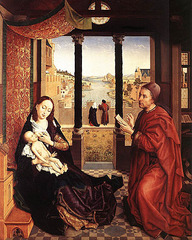
-commissioned for the painters guild in Brussels
-The panel depicts the patron saint of paitners drawing the Virgin Mary using a silverpoint ( a sharp stylus that creates a fine line). THe theme paid tribute to the profession of painting in Flanders
-Could be a self-portrait, identifying the Flemish painter with the first Christian artist and underscoring the holy nature of the painting.
-Rogier shares with Jan Van Eyck the aim of recording every detail of the scene with fidelity to objective appearance. From he rich fabrics to the floor pattern to the landscape seen through the window.
-Liek Campin and Van Eyck, ROgier imbued much of the representation with symbolic significance.
-The carved armrest of the Virgin’s bench depicts Adam, Eve and the serpent, reminding the viewer that Mary is the new Eve and Christ is the new Adam who will redeem humanity from the Original Sin.
Petrus Christus, Dirk Bouts,Hugo Van der Goes, Hans Memling

-Commissioned by the Bruges goldsmith’s build chapel
-portrays Saint Eligius (who was initially a master goldsmith before committing his life to God) sitting in his stall, showing an elegantly attired couple a selection of rings.
-the bride’s betrothal girdle lies on the table as a symbol of fertility and the woman reaches for the rind the goldsmith weighs,
-The artist includes a crystal container for Eucharistic wafers (on the lower shelf to the right of St ELigius) supports a religious interpretation of the painting and continues the Flemish habit of every day objects having secret religiuous meaning
-although it suggests a marriage portrait, it is assumed that the goldsmiths’ guild in Bruges commissioned the painting.
Saint Eligus was the patron cain of blacksmiths and metalworkers all of whom shared a chapel in a building adjacent to the meetinghouse.
-This would make sense as the painting depicts an economic transaction and focuses on the goldsmith’s profession
-the variety of the objects depicted in the painting serves as an advertisement for the goldsmiths guild.
-All the meticulously painted objects attest to the centrality and importance of the goldsmiths to both the secular and sacred communities as as to enhance the naturalism of the painting. The convex mirror in the foreground showing another couple and a street serves to extend the painter’s save into the viewer’s space, further creating the illusion of reality.
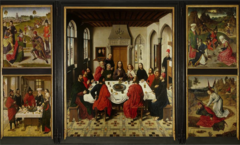
-became the official painter of Louvain (Flemish city) in 1468.
-the altarpiece of the Holy Sacrament, which was commissioned by the Louvain confraternity of the Holy Sacrament. It is one of the earliest Norther European examples of a single vanishing point. All of the central room’s orthoganals lead to a single vanishing point (in the center of the mantlepiece above Christ’s head)
-BUT the small side of the room has its own vanishing point, and neither it nor the vanishing point in the main room falls on the orison of the landscape
-In Bout’s last supper, he did not focus on the biblical narrative but instead presented Christ in the role of a priest performing a ritual from the liturgy of the Christian Church- the consecration of the eucharist
-This contrasts greatly with other last supper’s that focus on the betrayal, he adds complexity by adding four servants all dressed in Flemish attire. Theres servants are most likely portraits of members of the Louvain confraternity who are responsible for commissioning the altarpiece.-this continues the Flemish tradition of a biblical representation with portraits of the painting’s patrons, first noted in the Merode Altarpiece by Robert Campin

-Hugo painted the triptych for an Italian sip owner and agent for the powerful Medici family of Florence.
-The patron appears on the wings of the altarpiece with his family and their patron saints.
-The central panel depicts the Adoration of the Shepherd,
-Hugo display a scene of solemn grandeur, rather than the more typical joyous celebration related to this occasion
-The Virgin, Foseph and the angels seem to brood on the suffering that is to come rather than meditate on the Nativity miracle
-From the right the three shepherd enter, with powerful realism in attitudes of wonder, piety, and gaping curiosity.
-The wintry northern landscape unify the three panels, many symbols as Campin and Eyck and Bouts used
-The Iris and columbine flowers symbolize the sorrows of the virgin
-The fifteen angels represent the Fifteen Joys of Mary.
-Huge revives medieval pictorial devices, small scene in the background of the altarpiece, the flight into Egypt, the annunciation to the Shepherd, and the arrival of the magi.
-after this was placed in the family chapel in a Florentine church, caused lots of stir among Italian artists.
-They admired the incredibly realistic details.
-Memling specialized and portraits and images of the Madonna
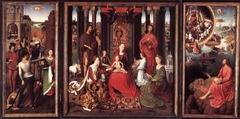
Altarpiece of the Virgin with Saints and Angels. (“The Saint John Altarpiece”) 1479. Groenigenmuseum, Bruges.
-combining biblical and secular scenes, portraits of patrons of the arts within biblical scene, strengthening relationship between Flemish and their religious beliefs
-sparkling and luminous colors, realistic depicitons of textures, tapestries, fabric, gold, jewels
-attention to small details such as the stubble on one’s face (done by the use of oil)
-hidden symbols to reveal the iconography of the work
-start of work with linear perspective, but not perfected, multiple vanishing points)
1) Robert Campin (Annunciation of St. Anne/Merod Altarpiece)
2) Jan Van Eyck (Ghent Altarpiece, Man in a Red Turban, Arnolfini Wedding)
3) Rogier Vande Weden (The Descent from the Cross/”The Prado Deposition,” Saint Luke Drawing the Virgin)
4) Petrus Christus (St. Eligius in his Goldsmith’s shop)
5) Dirk Bouts, (Last Supper/Altarpiece of the Sacrament)
6) Hugo Van der Goes (Adoration of the Christ Child
7)Hans Memling (Altarpiece of the Virgin with Saints and Angels, Portrait Diptych of Martin van Nieuwehove)
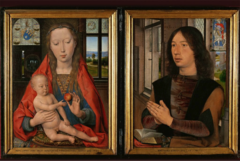
-portraits placed in an understandable space, highly realistic
-The donor on the right panel, Maarten van Nieuwenhove of Bruges, was born November 11, 1463. He belonged to a patrician family whose members held prominent positions both in the government of Bruges and in the Burgundian court. About five years after this portrait was painted, Maarten became a councilor, then later the captain of the civic guard, and finally the mayor of Bruges (in 1498). He died on August 16, 1500, at the age of 36.
-Hidden symbols: The apple, Christ will redeem humanity, reference to Adam and Eve
-inscription that
-convex mirror reveals they are in the same room, gives more clues about the space
-coat of honor for the can Nieuwehove family
-Saint Martin on the right
-among the most significant developments in French manuscript painting was a new conception and presentation of space. Paintings in the manuscripts took on more pronounced characteristic as illusionistic scenes
-increased contact with Italy, where Renaissance artists had revived the pictorial principles of classical antiquity, may have influenced French painter’s interest in illusionism
-They moved to Paris and worked for le due de Berry, of France. He was an avid art patron and focused on manuscripts
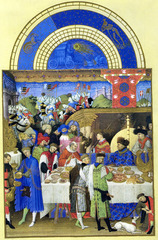
-This was commissioned by le due de Berry of France and was used as a book for reciting prayers.
-They replaced traditional prayers
-the center of it was an illustrated calendar listing local religious feasts and days preceding day of the blessed vrigin
-Tehy represent the 12 months in terms of the associated seasonal tasks
-Above each picture is a lunette (semicircular frame) in which they depicted the chariot of the sun as it makes its years cycle around the 12 zodiac signs
-references to nature, secular life, as del as references to antiquity (typical of renaissance)
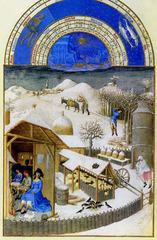
The Renaissance art already characterized the competition: patronage as both a civic imperative and a form of self-promotion, esteem to the artist, and the development of a new pictorial illusionism
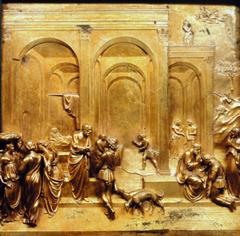
-three part story
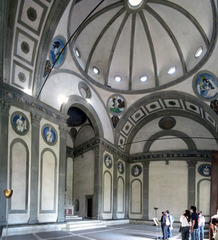
Pazzi Chapel Interior wall, Florence, beg. 1433.
Early Renaissance.

Sant’ Andrea, Mantua. Beg. 1472.
Early Renaissance.

David, 1440—1460.
Early Renaissance.
-The use of perspectival systems in relief sculpture and painting represents only one aspect of the Renaissance revival
-freestanding nude statues (antiquity revival)
-the first Renaissance sculpture to revive the nude free-satdnign sculpture was Donatello
-was commissioned by the Medicci family for the display in their courtyar, done in Bronze
-Donatello reinvented the classical nude, his subject was not a Pagan God or hero, but the youthful biblical slayer of Goliath, who became the symbol of Florentine republic independence, and was therefor an ideal choice for the residence of th emost powerful people in Florence, they found themselves responsible for Florentine independence
-The invoking of classical poses (appeal to humanists Medicci family, poses with the relaxed contrapposto stance with proportions of sensuous beauty, absent from Medieval sculpture.
![Donatello, Italian. Zuccone, 1423—25 Early Renaissance. Lo Zuccone (Italian: literally, pumpkin; figuratively bald-head) is a marble statue by Donatello. It was commissioned for the bell tower of the Florence Cathedral of Florence, Italy and completed between 1423 and 1425. It is also known as the Statue of the Prophet Habakkuk, as many believe it depicts the Biblical figure Habakkuk. The statue is known for its realism and naturalism, which differed from most statuary commissioned at the time.[1] In recent times it is gaining renewed popularity from its uncanny resemblance to 'Harry Potter' villain Lord Voldemort. Zuccone is reported to have been Donatello's favorite, and he was said to swear by the sculpture, Donatello, Italian. Zuccone, 1423—25 Early Renaissance. Lo Zuccone (Italian: literally, pumpkin; figuratively bald-head) is a marble statue by Donatello. It was commissioned for the bell tower of the Florence Cathedral of Florence, Italy and completed between 1423 and 1425. It is also known as the Statue of the Prophet Habakkuk, as many believe it depicts the Biblical figure Habakkuk. The statue is known for its realism and naturalism, which differed from most statuary commissioned at the time.[1] In recent times it is gaining renewed popularity from its uncanny resemblance to 'Harry Potter' villain Lord Voldemort. Zuccone is reported to have been Donatello's favorite, and he was said to swear by the sculpture,](https://artscolumbia.org/wp-content/uploads/2017/08/donatello-italian-zuccone-1423-25early-renaissance-lo-zuccone-italian-literally-pumpkin-figuratively-bald-head-is-a-marble-statue-by-donatello-it-was-commissioned-for-the-bell-tower.png)
Zuccone, 1423—25
Early Renaissance.
Lo Zuccone (Italian: literally, pumpkin; figuratively bald-head) is a marble statue by Donatello. It was commissioned for the bell tower of the Florence Cathedral of Florence, Italy and completed between 1423 and 1425. It is also known as the Statue of the Prophet Habakkuk, as many believe it depicts the Biblical figure Habakkuk.The statue is known for its realism and naturalism, which differed from most statuary commissioned at the time.[1] In recent times it is gaining renewed popularity from its uncanny resemblance to ‘Harry Potter’ villain Lord Voldemort. Zuccone is reported to have been Donatello’s favorite, and he was said to swear by the sculpture, “By the faith I place in my Zuccone.”[2] It is now in the Museo dell’Opera del Duomo in Florence.

The Gattamelatta. 1440s (Padua)
Early Renaissance.
-the increase emphasis on the individual and humanism led to increase amount of portraiture, antiquity poses and influence but secular subject or biblical subject (David)
-patrons commissioned portraits of themselves and commemorative portraits of deceased were also popular
-Donatello left Florence for Nothern Italy to accept a rewarding commission from the Republic of Venice to create a commemorative monument in honor of the recenty deceased Venetian army official who was nicknamed, Gattemelata.
-first to rival the mounted portraits of early Antiquity, such as that of Marcus Aurelius, which the artist most likely saw in Rome
-the structure stands on a loft elliptical base, massive majestic,unlike Marcus Aurelius sculpture, he did not represent the commander as superhuman, larger than the horse
-very poised, relaxed, stoic yet not emotionless positon, man and horse create an image of strength and power,
![Paolo Uccello, Italian. Battle of San Romano, c. 1455. Early Renaissance. -Teh interest in linear perspective, and the secular focus in Florentine art is sine of Early Italian Renaissance -the scene commemorates a Florentine victory over the Sienese in 1432, it recognizes Florentine victory but also acknowledges the Medici in symbolic form: he bright orange fruit placedbehing the unbroken sturdy lances, symbolizes the Medici family, as oranges were medical apples and Medici means doctor -linear perspective is empliyed, rationalized vision (very humanist) -orthogonals converging at vanishing point at the horizon -gives a sense of space They are significant as revealing the development of linear perspective in early Italian Renaissance painting, and are unusual as a major secular commission. The paintings are in egg tempera on wooden panels, each over 3 metres long. According to the National Gallery, London,[1] the panels were commissioned by a member of the Bartolini Salimbeni family in Florence sometime between 1435 and 1460. The paintings were much admired in the 15th century; Lorenzo de' Medici so coveted them that he purchased one and had the remaining two forcibly removed to the Palazzo Medici. They are now divided between three collections, the National Gallery, the Galleria degli Uffizi, Florence, and the Musée du Louvre, Paris. Paolo Uccello, Italian. Battle of San Romano, c. 1455. Early Renaissance. -Teh interest in linear perspective, and the secular focus in Florentine art is sine of Early Italian Renaissance -the scene commemorates a Florentine victory over the Sienese in 1432, it recognizes Florentine victory but also acknowledges the Medici in symbolic form: he bright orange fruit placedbehing the unbroken sturdy lances, symbolizes the Medici family, as oranges were medical apples and Medici means doctor -linear perspective is empliyed, rationalized vision (very humanist) -orthogonals converging at vanishing point at the horizon -gives a sense of space They are significant as revealing the development of linear perspective in early Italian Renaissance painting, and are unusual as a major secular commission. The paintings are in egg tempera on wooden panels, each over 3 metres long. According to the National Gallery, London,[1] the panels were commissioned by a member of the Bartolini Salimbeni family in Florence sometime between 1435 and 1460. The paintings were much admired in the 15th century; Lorenzo de' Medici so coveted them that he purchased one and had the remaining two forcibly removed to the Palazzo Medici. They are now divided between three collections, the National Gallery, the Galleria degli Uffizi, Florence, and the Musée du Louvre, Paris.](https://artscolumbia.org/wp-content/uploads/2017/08/paolo-uccello-italian-battle-of-san-romano-c-1455-early-renaissance-teh-interest-in-linear-perspective-and-the-secular-focus-in-florentine-art-is-sine-of-early-italian-renaissance-the-scene.png)
Battle of San Romano, c. 1455.
Early Renaissance.
-Teh interest in linear perspective, and the secular focus in Florentine art is sine of Early Italian Renaissance
-the scene commemorates a Florentine victory over the Sienese in 1432, it recognizes Florentine victory but also acknowledges the Medici in symbolic form: he bright orange fruit placedbehing the unbroken sturdy lances, symbolizes the Medici family, as oranges were medical apples and Medici means doctor
-linear perspective is empliyed, rationalized vision (very humanist)
-orthogonals converging at vanishing point at the horizon
-gives a sense of space
They are significant as revealing the development of linear perspective in early Italian Renaissance painting, and are unusual as a major secular commission. The paintings are in egg tempera on wooden panels, each over 3 metres long. According to the National Gallery, London,[1] the panels were commissioned by a member of the Bartolini Salimbeni family in Florence sometime between 1435 and 1460. The paintings were much admired in the 15th century; Lorenzo de’ Medici so coveted them that he purchased one and had the remaining two forcibly removed to the Palazzo Medici. They are now divided between three collections, the National Gallery, the Galleria degli Uffizi, Florence, and the Musée du Louvre, Paris.

Birth of Venus, c. 1480.
Early Renaissance
-comissioned by the Medici family, it is Boticelli’s recreation of lyrical painting of a poet’s retelling go the Greek myth, Zephyrusm carrying Chloris, blows Venus, born out of sea foam on a cockle shell, to her sacred island, Cyprus.
-the lightness and bodilessness of the winds propel all the figure without effort
-draperies undulate and move easily in the gusts, Boticelli depicts Venus as ndude, very rare win Medieval art, obviously a change, the artist uses ancient Venus statues to help draw figure
-he seems to ignore the new rules of linear perspective the background appears flat devoid of atmospheric perspective
-his paintings possess rhythm and lyricism that appealed to Florentine patrons
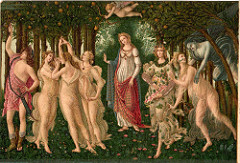
Primavera, c. 1482.
Early Renaissance
-commissioned by the Medicci family, was one of if not their favorite Florentine artists, focused on lyricism and rhythm, not as technical as other Early Renaissance painters
-Botticelli was a master of the contour line, method of using pure contour line with light shading within the contour
-he was clearly a master colorist, it features frieze like figures of classical inspired figures in the foreground and a lush background of orange trees in honor of the patron.
-Venus stands just to the right of the center with her son cupid overhead, reveals a portion of key that forms a kind of halo over her head
-the Three Graces based on antiquity (but clothed) are target of Cupid’s arrow, based closely to ancient prototypes
-ice cold Zephyrus , the west wind, is about to carry out nymph Chloris, whom he transforms into Flora, goddess of spring,
-the sensuality of the representation, the appearance of Venus in springtime, and the abduction and marriage of Chloris all suggests that the painting was commissioned on the occasion of a Medici wedding
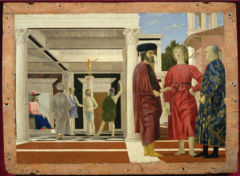
Flagellation of Christ, c. 1455—65.
Early Renaissance.
-Commissioned by very important commander Frederico, who is considered of the greatest patrons of the 15th century
-this is his most enigmatic painting, thesi is the setting of a new testament drama, the focus of the composition is not Christ, but the group of three large figures in the foreground, they appear to be discussing the events in the background, as Pilate (seated judge) watches Christ, bound to a classical column topped by a classical statue is about to be whipped, Piero’s perspective is so meticulous with the tiles and orthogonals.
-THe panel reveals his interest in mathematics, the careful delineation of the artist’s setting, suggests an architect’s vision,
-Pierro planned his compositions almost entirely by his sense of the exact lucid structure by mathematics
-was a skiled geometric figures
-His association with Alberti (influencer of linear perspective)

Camera Picta of the Palazzo Ducale, Mantua. 1465—74.
Early Renaissance.
-comissioned by Prince Ludovico Gonzaga, one of the most spectacular room in his palace, the duke’s bedchamber
-by integrated real and painted architectural elements,Mantegna dissolved the room’s walls in a anger that foretold later baroque decoration.
-Recalls the efforts of Pompeian painters to merge architecture and painting
-Second-Style painting
-this is the first perspectival view of a ceiling, Baroque later developed this even further
– the viewer becomes the viewed as figures look down into the room from the painted oculist convicted illusion of a blue sky with putti around
-the brilliantt feat of illusionism climaxes almost a century of experimentation with perspective
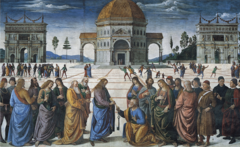
Christ Delivering the Keys to St. Peter, 1481-83. Sistine Chapel, Rome. FRESCO
Early Renaissance.
-Commissioned by the Pope in late 15th century, who summoned artists including Boticelli to Rome to decorate the walls of the newly completeld Sistine Chapel. –
-Perugino was one of the painters the Pope employed
-The papacy (Authority of the pope) based its claim of total authority of the Roman Catholic Church on this one biblical event
-In Perugino’s version, Christ hands the keys to Saint Peter, who stands amid an imaginary gathering of the 12 apostles and Renaissance contemporaries
-These figures mark the foreground of a great stage created by the converging orthogonals that extend into the distance at a vanishing point (temple’s doorway)
-duplicate triumphal arches serve as base for distant compositional triangle whose apex is at the center building
-he modeled after antiquity, similar to Arch of Constantine
-the arches parallel the close ties between St Peter and Constantine
-incorporated all the learning of the generations
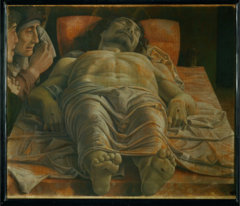
Lamentation over the body of Christ, c. 1500.
Early Renaissance.
-master of perspective
-strikingly realistic, biblical scene, careful linear perspective, Mantegna reduces the size of his feet, otherwise would have covered body
-tempering naturalism with artistic language,
-new style mannerism challenged it as soon as Raphael died
-the leading artistsics center were of Central Italy (Flornce and Rome) where three of the greatest artists who ever lived were
— Leonardo da Vinci, Raphael and Michelangelo
-he wanted to discover the law unerlying the processes and flux of nature
-he studied human anatomy and contributed immeasurable in physiology
-he believed in the absolute sense, reality was inaccessible and that humans could know it only through changing images
-in 1481, Leonardo left Florence and went to the ruler of Milan, he remained there for almost 20 years

Madonna of the Rocks, 1483.
High Renaissance
This was painted shortly after settling in milan, was used as the central panel for an altarpiece for the chapel of the Cofraternity in Milan
-the painting buds on Masaccio’s understanding and usage of chiaroscuro, the subtle play of light and dark
-modeleing emotional states using light and shadow were, for Leonardo, the heart of painting
-he presented the figure in a pyramidal grouping, interest in geometry and form, the unified representation of object in an atmospheric/obscure setting was a manifestation of his scientific curiosity about the invisible substance surrounding things
-The Madonna, Christ Child and infant John the Baptist, and angel emerge in the nuance of light and shafwo from the half-lit cave and strange landscape
-Light simultaneously veils and reveals the forms, immersing them in a layer of atmosphere.
-Leonardo employs atmospheric perspective is the resul of new medium- oil paint- which was previously used by northern painters
-The figures pray, point and bless, unifying the individuals portrayed
-John prays to the Christ child who blesses John in return
-the Virgin left hand reaching toward the Christ child and her right hand protecting John’s shoulder
-visually unified, spatially convincing image
-Leonard wanted to express *** “the intention of the soul”
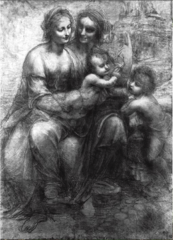
Drawing for the St Anne Altarpiece, 1505–07.
High Renaissance.
-In the 16th century in Italy, drawing assumed a position of greater prominence than ever before in artistic production due to the introduction of less expensive paper.
-tranquil, grace, idealistic, balance
-The glowing light falls gently on the majestic forms in a scene of tranquil grandeur and balance
-Leonardo ordered every part of his cartoon with a pictorial logic that result in visual unity
-the stately grace of the movement, idealized figures, reminds of Greek statues of goddesses in the pediment of the parthenon.
-his infusion of the principles of classical art into his design,
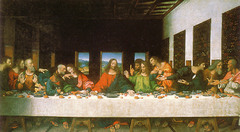
Last Supper, 1495-98.
High Renaissance
-commissioned for the refectory of a church in Milan,
-Christ and his 12 disciples sit at a long table placed parallel to the picture plan in a simple, spacious room.
-The austere setting amplifying the highly dramatic action
-Christ with his outstretched hands, has just said, “One of you is about to betray me.”
-A wave of intense excitement passé through the group
-Christ appears isolated from the disciples and in a perfect repose, the calm eye of the storm emotion swirling around him
-the curved pediment arches above his forehead frame his figure
-the architectural curved pediment as well as the light serve as a halo around the figures head
-Christ’s head is the focal point of all the converging perspective lines in the composition
-Christ is btw the psychological focus of Leonardo’s fresco and the focal point of the converging orthogonals, the composition conveys meaning
-he presents the agitated disciples in four groups of three, united among and within themselves by the figure’s gestures and poses
-the two disciples at the tables ends are quieter than the others, to bracket the tables energy,
-the disciples register a broad range of emotions, more intense towards Christ
-landscape is parallel
-food evenly distributed
-who DONE IT
-everyone talking and pointing in groups of threes, energy all goes towards the center focus, strong linear perspective
-Christ sits stoiclly whyile the rest there is a lot of energy

Mona Lisa, 1503—05.
High Renaissance

Anatomical Drawing, Left. C. 1511—13.
Designs for a central plan church, Right. C. 1500.
High Renaissance
-Leonardo completed very few painting, his perfectionism, relentless experimentation, and far-ranging curiosity diffusing his efforts
-in his later years his interests were increasingly involved in science/knowledge of the outside world
-his investigations in outside led to drawings like this
-analytical anatomical studies epitomize the scientific spirit of the Renaissance,
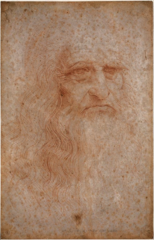
Self Portrait Drawing, Left. C. 1512—15.
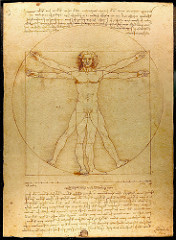
-“warrior Pope”
-His selection of the name Julius, after Julius Caesar, reinforced the perception
-had a 10-year papacy in which he was an avid art patron, understanding the propagandistic value of visual imagery.
-IN 1508, Julius called Raphael to thepapal court room, he studied in Perugino’s studio : ‘Christ delivering the Keys of the Kingdom to Saint Peter’
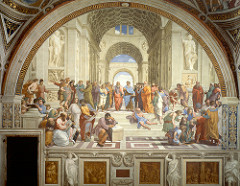
School of Athens, 1512.
High Renaissance. -Julius II gave Raphael his most important commission, the decoration of the Papal apartments in the Apostolic Palace of the Vatican
-Raphael patines the Stanza della Segnatura (Papal library) on the four walls of the library, under th headings Theology, Law (Justice), Poetry, and Philosopju)
-Raphael represented images that symbolized and summed up Western learning as Renaissance society understood it
-the frescoes refer to the four branches of human knowledge
-the four pictures put a balanced image of the pope
-the setting is a congregation of the great philosophers and scientists of the ancient works
-recalls ancient architecture, an approximate appearance of the new St. Peter’s
-Plato and Aristotle serve as the two central figures around whom Raphael careful arranged the others
-ancient philosophers, men concerned with the mysteries of the world stand on Plato’sside
-Aristotle’s side are the philosophers and scientists interested in human affairs
-Lower left, Pythagoras writes
-Euclid may be a portrait of Bramante (commissioned for St Peter’s)
-the figures pose with self-assurance and natural dignity, balance and tranquility/confidence
-Raphael’s convincing depiction of vast perspectival space
-the composition conveys the meaning:
-he harmonized not only the Platonists and Aristotelians but also Paganism and Christianity
-imaginary gathering of classical antiquity
-in the center framed by an arch in background, two greatest Plato and Aristotle, surrounded by many other
-Euclid to the bottom right, showing displaying some geometric theorum
-linear perspective, orthogonals lead the eye towards the middle background, vanishing point in the middle of Aristotle and Plato
-totality of composition is arranged on horizontal planes, carefully arranged in series of parallel planes (transversals)
-two many philosophers show interest in ancient sculpture, have a sense of mass and weight (first Giotto, Massacio) brought to a perfection here, have a sense of gravity and three-dimensionality, occupy space and bear weight on their feet
-each of four walls are painted with poetry, theology, law and philosophy (in the library)
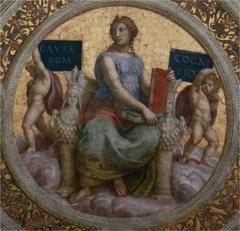
Personification of Philosophy, above theSchool of Athens, 1512.
High Renaissance.
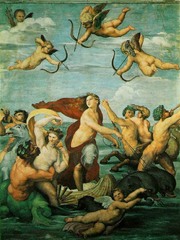
Galatea, 1513.
High Renaissance.
-comissioned not by Julius II but by a wealthy Italian banker, he wanted to decorate his palace on the Tiber River with scenes of classical mythology
-In the fresco, Falatea flees on a shell drawn by leaping dolphins as she escapes from her uncouth lover, the Cyclops Polythemus, sea creatures and playful putti surround her
-the painting erupts in joy and exuberance
-Compositionally, Raphael enhanced the liveliness and dashing movements that always return to her energetic core, centralized, the putti repeat that circular motion that surround her
-The figures are conceived sculpturally, with weight and movement, realistically depicting the way the drapery fall on Galatea, her body is strong, forceful, with lots of weight, in contrast to Botticelli’s delicate, hovering and dematerialized Venus
-resurrect the naturalistic but idealized forms and the pagan, classical world
-does relgiious pictures,
-diesvery young in 1520
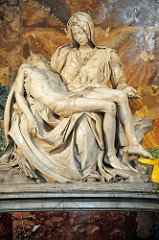
High Renaissance.
Michelangelo’s wanderings took him to Rome around 1498, this is his first masterpiece, commissioned for a French cardinal.
-the cardinal commissioned the statue to darn the chapel in Old Saint Peter’s in which he was to be buried
-The theme: Mary cradling the dead body of Christ in her lap, a staple of the repertoire of French and German artists
-The Italian, hover, rendered the Northern theme in an unforgettable manner.
-he transformed marble into flesh, hair, and fabric with a sensitivity to texture
-captures the tender sadness of the beautiful Mary as she mourns the death of her son
-she appears almost younger the Christ (subject of controversy)
– he explained this as an integral part of her purity and virginity, Christ seems less to have died that to have drifted off into a peaceful sleep, wounds are invisible
-interest in anatomy and naturalistic form, idealized and modeled after sculptures of antiquity

High Renaissance.
-David was a civic symbol of the Florentine republic, ld to the Florence Cathedral building committee to invite Michelangelo to work a great block of marble left from an earlier aborted commission into another statue of David
-was symbol, just as David had protected his people and governed them justly,whoever would rule Florence would do the same
-Despite the traditional association of David with heroism, Michelangelo chose to represent the young biblical warrior not after his victory, with Golaith’s head at his feet, but turning his head to the left
-his rugged hands sturdy body shows his strength, attention to an idealized human anatomy
-modeled after classical nudes, he greatly admired Greco-Roman statues, heroic rendering of the human physique.
-poised and tranquil, still evoking the historical psychological insight and internal emotionalism of Hellenistic statues
–so different than Donatello’s, instead of completed battle, he shows the emotionally connected presence of something unseen, ichelangel liked to depict towering pent-up emotion
-this sculpture led to many papal commissions
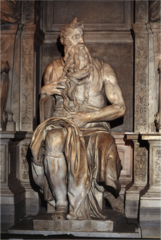
Moses (for the tomb of Pope Julius II), 1513–15.
High Renaissance.
-the formal references to classical antiquity appear led to Julius II, he associated himself with the great Roman Empire (from Daivd)
-This sculpture was the first commissioned by the pontiff, for his tomb no less, to be placed in old Saint Peter’s
-meant to be seen from below and to be balanced with seven other massive forms related to it in spirit,
-he depicted the Old Testament prophet seated, the Tablets of Law under on arm and his hands gathering his voluminous beard
-The horns that appear on Moses’s head were a convention in Christian aart (based on the mistranslation of the Hebrew word “rays”)
_Michelangelo again uses the turn head (like in David) which show a pent-up emotional inter stirring drama
-Msucles bulging, veins swollen, not since HELLENISTIC times had a sculptor captured such pent up energy (both emotional and physical) in a seated statue
-David and Moses capture powerful emotional states form within, pent up energy (Hellenistic)
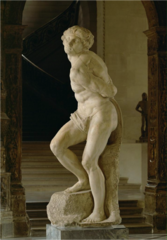
Bound Slave (for the tomb of Pope Julius II), 1513—15. .
High Renaissance.
-Michelangelo originally intended the tomb of Pope Ulius II to have over 20 statues of captives, in various attitudes of revolt and exhaustion
-the turned head again, idealized beautiful figure
-Hellenistic influence of pent-up emotion
Sistine Chapel Ceiling, 1512..
High Renaissance.
-Julius II suspended work on his sculpture tomb and gave Michelangelo the commission of the sistine chapel in 1508, Michelangelo did not want to do, siting painting was not his profession
-had to be done in fresco, girnotta, challenge of drying really quickly, high ceiling really wide dimensions
-the patron’s agenda was to paint the Church doctrine, themes of the creation, the al, and redemption/humanity
-weaving together more than 300 figures in an ultimate drama of the human race
-a long sequence of narrative paths, from the creation, as recoded in Genesis, runs along the crown of the vault, from God’s Separation of Light and Darkness (above the altar) to Drunkenness of Noah (nearest the entrance to the chapel)
-Thus, as viewers enter the chapel, look up, and walk toward the altar, they review in reverse order, the history and fall of humankind
-The overall conceptualization of the ceiling’s design and narrative structure not only presents a sweeping chronology of Christianity but also is in keeping with Renaissance ideas about Christain history
-this includes: conflict between good and evel and between the energy and youth and wisdom of age
-unlike Andrea Mantegna’s decoration of the Camera Picta in Mantua, the strongly unifying architectural framework in the Sistine Chapel does not reproduce “picture window” rather the focuses on figure after figure, outlined against the neutral tones of the architectural setting
-Michelangelo believed the body was a manifestation of the soul and state of mind
-they appear to be tinted reliefs, playing with light and dark
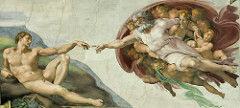
Creation of Adam, Sistine Chapel Ceiling, 1512..
High Renaissance.
-this is part of the ceilings central panels, Michelangel did not paint the traditional representation but instead produced a bold humanistic interpretation of the momentous event
-God and Adam confront each other in a primordial uniformed landscape
-life leaps to Adam from the spark of God’s finger, might hand of God
-the blunt depiction of the Lord as ruler of Heaven in the Olympian pagan sense indicates how daily High Renaissance thought Chritsianity joined Pagan tradition
-Beneath the Lord’s sheltering left arm is a female figure, apprehensively curious but as yet uncreated, scholars traditionally believed her to represent Eve, but many now think it is the Virgin: with Christ child at her knees: incorporated tenet of Christian ffaithL the belief that Adam’s Original Sin eventual led to the sacrifice of Christ, which in turn made it possible for the redemption of all humankind
Adam’s hand as you follow leads your eye to the baby Christ Child’s face, focal point of the right-to-left movement- The reclining position of the figures, heavy musculature, pent-up emotions (Hellensitic influence, twisting poses intricate parts: all typical of Michelangelo
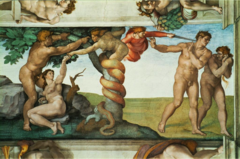
Fall and Expulsion of Adam&Eve, Sistine Chapel Ceiling, 1512.
High Renaissance.
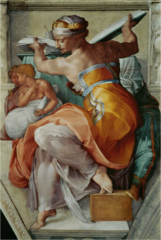
Sibyl from Sistine Chapel Ceiling, 1512.
High Renaissance.
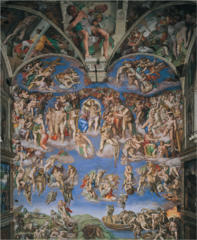
Last Judgment, Sistine Chapel, , 1536–41.
High Renaissance.
-Paul III’s first papal commission, for the altar wall of the Sistine Chapel
-Michelangelo depicts Christ as the stern judge of the world, a mighty giant, he raises his mighty right arm in a gesture of damnation so broad and universal as to suggest he will destroy all creation
-Olympian Pagan depiction, suggests connection High Renaissance artists felt between classicalism and Christianity
-The choirs of heaven around him pulse with anxiety and awe
-martyrs are depicting, some who endured agonizing deaths (st. bartholomew, who was skinned alive, its face a grotesque self-portrait of Michelangelo
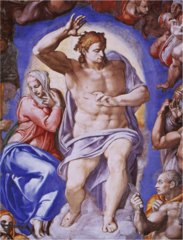
Last Judgment, Sistine Chapel, and detail of Christ&Mary, 1536–41.
High Renaissance.
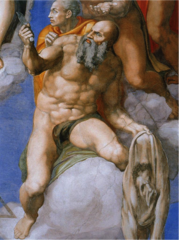
Last Judgment, Sistine Chapel, and detail of St. Bartholomew, 1536–41.
.High Renaissance.

Last Judgment, Sistine Chapel, and detail of Condemned Soul, 1536–41.
.High Renaissance.
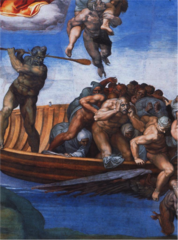
Last Judgment, Sistine Chapel, and detail of the Bark of Hell, 1536–41.
.High Renaissance.
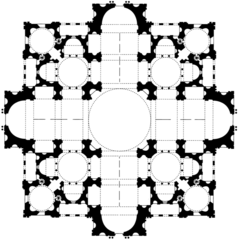
Proposed groundplan of New St. Peters, Rome. 1505
High Renaissance
-Rebuilding Old Saint Peter’s was important to the Renaissance Papacy
He went to Milan like Leonardo and stayed there until the French arrive in 1499
– he abandoned painting to become an architect
-0Influence of Brunelleschi, Alberti and painter Leonardo, of whom all favored the architecture and art of classical antiquity, Bramante developed the High Renaissance form of the central-plan church
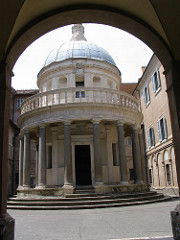
Tempietto (at San Pietro in Montorio, Rome), 1502
High Renaissance
-based on humanistic values on reviving the ancient Roman models, the building received its name because it appears to look like a little ancient temple
-the round temples of ancient Rome directly inspired his design
-Patrons: King Ferdinand and Queen Isabella of Spain
-plan circular STYLOBATE (stepped temple platform)
and an austere Tuscan style colonnade
-Bramante achieved a wonderful balance and harmony in the relationship of the dome, drum and base, very unique, although resembles the Greek Tholos, it is different with the combination and new, (Classical Tholoi did not have a drum nor balustrade

Tempietto (at San Pietro in Montorio, Rome), 1502
High Renaissance

-Bramante was the architect Julius II selected to design the replacement for the Constantinian basilican church of Old Saint Peter’s
-did not suit the ambition;s of the pope’s taste ofr the colossal
-Saint Peter represented the history of the Church
-he designed the plan to consist of a cross with arms of equal length each terminating in an apse
-Julius II intended the new building to serve as a martyrdom to mark Saint Peter’s grave and also hoped to put his tomb in it
-a large dumb would cover the crossing and small domes over the subsidiary chapels
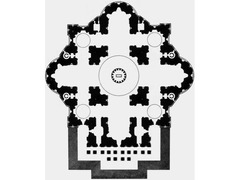
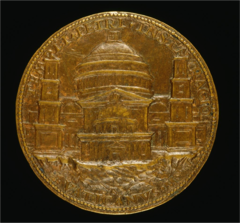
Medallion showing Bramante’s Plan for New St. Peters, Rome.
High Renaissance. 1506.
-a commemorative medal
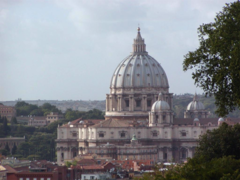
Dome of St. Peter’s Basilica, Rome (completed after his death, 1590)
High Renaissance.
employing the classical contrapposto pose.
SPACE: Generally constructed using linear perspective; orthogonals,
transversaals & vanishing point employed to give sense of scientific space. Northern Renaissance works are less adept at scientific perspective until later in the 15th C.)
COLORS: Natural and descriptive, balanced and harmonious. COMPOSITIONS: Frequently centralized or parallel to the picture plane. LIGHT: Usually even, overall lighting. Sfumato (“smoke”) in Leonardo. MOOD: Graceful and harmonious, as if the beings in a Renaissance
picture inhabit an ideal world; states of mind are certain and stable.
OTHER: Use Wolfflin’s terms to discuss the style: (linear, planer, multiple,
tectonic (closed), clear. Note the use of oil technique early in the north and tempera & fresco in Italy. Italian High Renaissance differs from the Early Italian Renaissance primarily in the superb perfection of the traits listed here.)
on the verge of losing their balance.
SPACE: flattened, everything often pushed up to the surface of the picture plane;
sometimes great leaps from foreground to background.
COLORS: Sometimes acid or acrid colors, non-natural and expressive. COMPOSITIONS: Often conflicting and asymmetrical.
LIGHT: Like the Renaissance, light is more often than not even and uniform.
(Sometimes more dramatic effects as in Titian, Tintoretto).
MOOD: Tense, strange, abnormal; sometimes with uncontrolled emotion. OTHER: Note that not all works will exhibit every trait of the style.
SPACE: Concern for the infinity of space beyond the picture frame and often
encompassing the viewer’s space.
COLORS: Natural and descriptive.
COMPOSITIONS: Frequently based on diagonals across and into the picture
surface. Compositions are “open”.
LIGHT: Often strong diagonal lighting, as in Caravaggio and his followers.
(“cellar lighting”) Pictures unified by strong “chiaroscuro.” (But note Poussin and classicistic Baroque painters as exceptions.)
MOOD: Interest in psychology, extreme–but natural–states of mind: anger, fear, ecstasy, sadness.
OTHER: Use Wolfflin’s vocabulary to describe: Painterly, diagonally recessive, a-tectonic (open), unified, unclear. Use Martin’s concepts to describe: Naturalism (sometimes concealing allegory), interest in psychology, idea of the infinity of space.
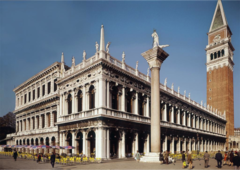
Library of San Marco (right). Venice, beg. 1536
the library is aopen and light, and the mint is more fortress like (a treasury building), give sensation that banks like to give (sturdiness)
-designed and built over a long period of time
-economic wealth of the city invited a lot of very wealthy artists
-library is open loges on the ground floor and above
-balistrade at the top and statues
-obelisks at the four corners, very graceful, decorative
-The Mint has rusticated massondry, strength and power and civic authority

Library of San Marco (right). Venice, beg. 1536
the library is aopen and light, and the mint is more fortress like (a treasury building), give sensation that banks like to give (sturdiness)
-designed and built over a long period of time
-economic wealth of the city invited a lot of very wealthy artists
-library is open loges on the ground floor and above
-balistrade at the top and statues
-obelisks at the four corners, very graceful, decorative
-The Mint has rusticated massondry, strength and power and civic authority

High Renaissance.
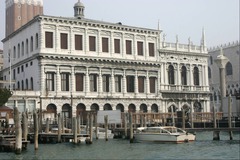
High/Venetian Renaissance.
-Giovanni Bellini (1430-1516), trained in the International Style, he worked in his father;;s shop and did not develop his own style until his father’s death in 1470
he became familiar with mixed oils, must have came in contact with Flemish painters
-oil is wider in coloristic range than tempera or fresco
-Belinni abandoned Mantegna;s harsh linear style and developed a sensuous coloristic manner that was to characterize Venetian painting
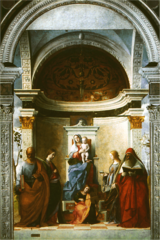
San Zaccaria Altarpiece, 1505.
High Renaissance.
-Belinni earned great recognition for his many Madonns, which he painted both in half-legnth on small devotional panels and in full length,
-one of his earliest major commission, Virgin Mary sits enthroned, holding the Christ Child, with saints flanking her
-Bellini placed the group in a carefully painted shrine, attributes aid the identification of all the saints: Saint LUcy holding a tray with her plucked out eyes, Saint Peter with the key and the bok, Saint Catherin with the palm of martyrdom and the broken wheel and Saint Jerome with a book
-At the foot of the throne sits and angel with a viola
-painting resonates spiritual calm
-balanced presentation of color and light, outlines dissolve in light and shadow: growing color produced a soft radiance that envelops the form with an atmospheric haze
-very quickly adapts to a high reniassance style
=has wonderful remoteness of a high renaissance painting, perfectly calm, slightly removed from us, figures are heroicly ideal
-the persepctive is perfect, space is perfect, the colors are natural and the figures have a sense of weight and gravity (influence of anitquity)
-Madonna and child on a throne, proportioned in a perfect way, child seems like a perfect baby
-the saints that surround the throne
-standing in poses that characterize them
-St. Lucy’s eyeballs are on the trey (saints depicted wth their function)
-sacred conversation, mental communing among the saints
-patron saints stand as intercessors
-italians invented the “sacred conversation”
-kind of removed from our world, in an ideal space, ideal form, but not terribly approachable, no interraction with the spectator
-the musical angel is th eonly one htat looks out at us
-the holy saints are not actively communciating with us
-whole of the conversation is removed, very high on the wal, not like Massacio’s holy trinity, we read as a three dimensional space on a wall
-this is a separate space of an idealized sort just as the figure themselves
-figures belong in the space, believe they have mass
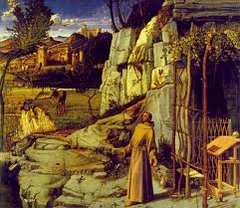
St. Francis in Ecstacy (or St Francis in the Desert), 1480—90. .
High Renaissance. -founder of Venice Renaissance art, was a great painter who painted in an early renaissance style and then adopted the idealized forms of the high renaissance style
-was also the teacher of Girogone and Titian and a close friend of Duher
-crutial role beteen early and high style
-1480s, earlier
-St. Francis in ecstacy, foudner of the St. Franciscan orders
-shows him in the wilderness at a time when he was about to receive stigmata
-St. Francis as a hermit admiring nature and giving thanks to nature (St. who is most closely connected to nature) shown with his hermitage out in the wildernes, simple desk and prayer book with a skull (reminder of death)
-puts down his book and communes with nature
-there are rabbits, donkey, crane (signs of wilderness)
-light is falling from upper left hand corner and the tree bends towards him, connecting with nature
-image of one of the great saints, early renaissance stage
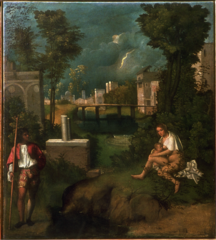
The Tempest,c. 1510
High Renaissance.
-Venetian artist, student of Bellini, much of the credit is given to him for developing the poetic manner of painting
-Bellini was his teacher, came from a town near Venice
-displays interest in poetic qualities of the natural landscape inhabited by humans
-dominating the scene is slush landscape, stormy skids and lighting in the middle background threaten the tranquility of the pastoral setting
-pushed off to both sides are the human figures- a young woman nursing a baby in the right foreground and a man carrying a halberd (a combination spear and battle-ax) on the left
-much debate over the painting, possibly no definitive narrative to the piece, which is appropriate for the Venetian poetic rendering
-some scholars suggest biblical or mythological narratives
-the debate heightens the uncertainty and enigmatic qualities of the piece
-died very young after leaving Bellini’s workshop
-secular painting, done for a bedroom or a sitting room of a wealthy Venetian
-archiecture in the distance
-Venetian art is characterized as being poetic, with interest in landscapes, less architecture
-mother wither her child at right and left hand side is a soldier wearing tight pantaloons and carrying a spike
-could be virgin marry and Joseph, BUT not represented correctly,. Not a soldier, also she is nude from waste down
-looks like post classical times (town in the background)
-could be a storm cloud, get sense people are being enveloped by the storm cloud in the background, looks like it might be lightning
-died of the plague, had great potential
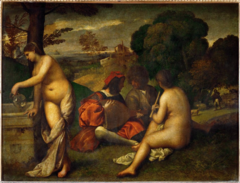
The Concert, 1508—1511,
High Renaissance.
-exemplifies poetic and arcadian influence of Bellini, both their teachers
-Out of the dense shadow emerge the soft forms of figures and landscapes
-mood of tranquil reverie and dreaminess over the entire scene, evoking the enigmatic in lighting
-two nude women, accompanied by two clothed men, occur the rich abundant landscape
-the Shepherd symbolize his poetry
-twp women men are invisible inspiration for the two men, the voluptuous bodies of the women, modulated by the smoky style, is the standard in Venetian art
-poetic personification of nature’s abundance
-early work of Giorgione’s student Titian;
-a little bit of archietcure in the background
-but primarily about the beautiful nude figures in the foreground
-arcadian references, this is the land of perfection, ease and beauty when poetry and music are the paramount concerns, does a large number of classical subjects
-this is referred to as the concert
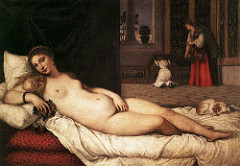
The Venus of Urbino, 1536—38,
High Renaissance.
-Had worked with Girogonne and Bellini
-Titian dominated the art of the city following their deaths
-poetic pastural representations of musicians and nymphs
-Venus figure, could be a disguised portrait
-nude female figure reclining, pushed up front by the curtain behind her, distinct silhouette
-the room behind her gives a different flavor
-don’t necessarily
-dog (fidelity and love) could be disguised portrait
-after this picture, there are two dozen representations of Venus

Bacchus & Ariadne, 1522-23,
High Renaissance. Oil on Canvas
-classical subject, Bachhus rescuing Ariadne, Bacchus the God of wine with his entourage of drinkers
-commisioned for a duke for his house
-The patron had requested one bacchanalian scene each from Titian, Bellini, Raphael, and Fra Bartolommeo.
-Titian produced three
Bacchus, accompanied by a boisterous and noisy group, arrives in a leopard drawn chariot to save Ariadne, whom Thesus abandoned on the island of Naxos
-Titian reveals his debt to classical art, Titian’s rich and luminous colors add sensuous appeal to this painting, making it perfect for the duke’s pleasure chamber
-based on figures and statues of antiquity
-lots of noise,
– important change occuring in Titian’s time was the almost universal adoption of canvas, with its rough-textured surface, in place of wood panels for painting
-established oil on canvas as the typical medium of the Western pictorial tradition

Pesero Madonna, 1519-26,
High Renaissance
-whole famly is represnted at right
-bishop and soldier
-entire family is being introduced into heaven by St. Joseph
-primary religious figures are associated with these massive columns
-reminiscent of Bellini’s work, the way it is framed in a beautiful renaissance real architecural frame, picks up the foreground frame to match the real architecutre
-illusionistic connection to the real
-puts picture inside the niche, like inside an arch
-wonderful capitas on each side
-Bellini’s picture is much more centralized, Tititan instead turns it sideways to make more dramatic, puts madonna off to one side, gives series of triangulars
-pyrimidal architecture of Raphael (typical of high renaissance)
-St. Francis in brown
-St. Joseph has key to heaven
-Pessero family portraits at the right side, older and younger ones, only one of them looking out at us
-Alberttii, in one passage of his books (published 100 years before this) he recommended to painters that they had atleast on picture in the painting to look at the viewer with driect eye contact to pull viewer in
-have one figure look directly in the viewer’s eyes
–
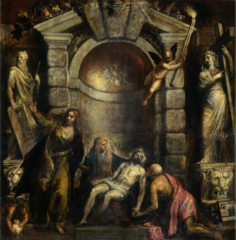
The Pieta, 1570–76,
High Renaissance
-subject similar to Michaelangelo’s subject the Pieta
-paitnign was intended for his own grave, was compelted by a person close in his circle
-mostly Titian
-shows how much his style has changes
-The Bachus picture is much more bright, clear, dilineated
-this is very painterly, can se the brushstrokes everwhere, indicate texture
-burshstrokes dematerialize the forms, forms become less substantive, done through his painterly techniques that wllow brushstroke to show, do not see sharp silhouettes, but forms seem to disolve into the background, not a sharp edge like his previous works
-triangular forms everywhere, a couple paintings leaned against the architecture
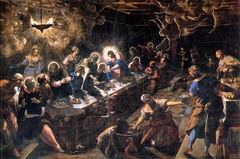
Last Supper, 1594.
Mannerist.
-different than Leonardo dvinci’s where disciples are arranged in one single row lined up, all parallel forms
-table is slanted at 30 degree right trangle through the painting
-Christ is not the most prominent figure, givign the Eucharis to one of his disciples, not about the betrayal (that is what Leonaro tells with sense of energy running through the disciples)
-a lot of action in antipication of reciving th eucharis
-beginning to get into different area, emphasis on the servants, food preparation, the witnesses to the last supper, all occuring at night
-lit strangely and lanterns held up in the ceiling giving off a mystical light with angelic figures who have joined the celebration
-Christ is still in the center although the table is at a thirty degree angle
-good comparios with the DURK Boust, no single bursh stroke, more about the icon, square table, no energy, space is very different
-Leonardo’s parallel to the front picture plane, point out that it is a different incident in the story
-Tinteret’s is the institution of the eucharis, Leonardo’s is about how one of you will betray (different story and consquencesin the way they are posed)
-lots of energy, more painterly style, as Titian did later in his career
-why this composition, why 30 degree angle
-Tinteretto’s painting is in St George church in Venice, deisgned by Pallatio, focul point of a monastary with all the associated buildings
-façade o
Among the features most closely associated with Mannerism is artifice. All art is artifice in the sense that art is not “natural” it is a representation of an idea. But many artists including High Renaissance painters such as Leonard and Raphael chose to conceal that artifice by using such devices as perspective and shading to make their art look natural.
Mannerism painters consciously revealed the constructed nature of their art. Renaissance artists strove to create art that appeared natural, mannerists wanted to show the contrived nature of it through ambiguous space, departures from expected conventions, and unique presentations of traditional themes.
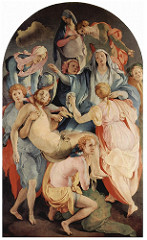
Descent from the Cross, 1526-28.
Mannerist.
-exhibits almost all the stylistic features characteristic of Mannerisms’s early phase in painting.
-expressive style, non-naturalistic, strange colors, elongated figures, compressed figures, strange emotions, lasted from 1520-1600 Manerism
-off balanced awkward poses
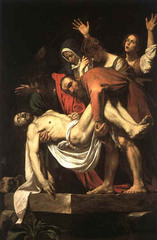
Entombment of Christ, 1603.
Baroque.
-in 1600 there was a conscious changing of the style from Mannerism, reformers came at the beginning of the 17th century
-Carvaggio (most important reformer) came to Rome in 1600, begins to paint in a much more naturalistic fashion
-his deposition, lower of Christ into the tomb
-figures are more naturally proportioned, colors are more naturalistic, red and yellow white and brown colors you see in nature
-emotions are represnted in a way we can relate to, human emotions (specifically Greek)
-Carvaggio has a preference of strong ontrsts of light and dark (very deep shadows)
-most paintings in earlier periods, evenly lit so the light is even over the entire painting
-generally in Baroque there is strong light and dark contrasts, can wee parts of the pictures fading into thdistance
-shadow carves the figure
Chiarosturo (light dark)
-picture is organized on basis of strong contrasts
-space comes forward in Baroque period, as well as backwards, space begins to be an aspect of the picture that unites the viewer with the composition
Stone beneath the figures come out into your face
Can tell whih direction the light is coming form, fairly high, falls in the figure below
Stone Is projecting into your space in an illusionistic fashion
Open composition, comes out towards you, envelops the viewer
Naturalistic colors, natural proportions to figures, openign of compisiton, compositions based on diagonal ressession as opposed to linear perspective (no perspective in mannerism)
Diagonal line across picture plane towards picture, Mary Magdaline in the background
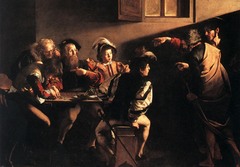
The Calling of St. Matthew, 1597—1601..
Baroque.
-done for the center piece of a chapel based on the life story of st. Matthew, show Christ calling St. Mathew
-Christ surrounded by his body guards
Sword moves towards us and opens up composition
Christ and Peterm Christ is illuminated coming from a high source on the right side (usually on eft)
Strong shaft of diagonal space, cuts across the figures, cuts the side of his face, cheeks see hollow very aesthetic
Outstretched hand as he gestures towards Matthew
Peter is also gesturing in that direction
Lighting come from a high position (cellar lighting) strong shaft of light through a cellar
-common in baroque art, arrangement in ligth and dark areas chiarosco,
-light of Christ coming into the room and illuminating
Includes everyday kind of people in a religious work, people he encoutnered
-gesture Christ makes is not accusatory, figners slightly bent (very anturalistic(similar to the gesture of Adam on the sistine chapel ceiling)
-gesture Carvaggio uses of Christ, Christ is the new Adam, he redeems the sins of the old Adam from the Old Testament
-his first name was Michelangelo, he felt this kinship with great High Renaissance masters, looking at a lot of their masters
Carvaggio does not idealized them
-Carvaggio makes his forms natural real andrelatable while Michelangelo makes them idealized and heroic
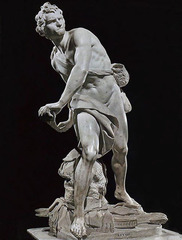
David, 1623.
Baroque.
-relgiious suubejct from old testament
-infuses naturalism, detail and emotion, mannerism is gone as Carvaggio did with paitning
-Bernini shows David in the act of killing the lion
-he is twsting and turning, intersects space in 360 degrees
-Renaissance scultpure you can understand from the front, primary view is from the point, this one there is no particular view, every view tells you soemthign new or different, David has wound himself up like aspring about to let the tock go
-he has a face that looks like he is intently focused on his target
-Michelangelo’s David: is powerful and heroic, but quiet, an icon, not in action, symbol of the power of David (the City of Florence) always see David from the front, from Bernini you have to walk all the way around it, comes out and impinges on your space, it is open onto your space
-Michelanglo’s face is serne and calm yet powerful, no extreme emotion
-Bernini is tense and natural hair is equally involved, flies out the top like flies, all about moveemnt action and inteensity but very naturalistic
-Bernini apporpriate and natural to the action

Apollo & Daphne, 1622-24.
Baroque.
-Baroque naturalism, reaction to mannerism by moving back to a more naturalistic style, open compisitons that theatrical quiality that bring the viewer in
-This is classical subject, popular like in the Renaissance as in Baroque
-Apollo was struck by an arrow and falls in love with Daphne and Cupid strikes daphne cuasing her to revolted by Daphne
_Apollo chases Daphne and almost catches her but Daphne’s father turn her into a loral tree to protect her
-as she runs in panic she starts to grow panic, bark is growing up her back, her toes are morphing into trunk
-laurel branch is special symbol
-he compeltely transmutes the material,
-white hard marble looks ike roots, leaves, her hair is so natural does not look like hair
-hard marble, transmutes this, Bernini is a magician with Marble
-does sculpture like Jan Van Eyk does paingint
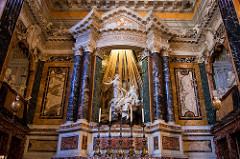
Ecstasy of St. Theresa, 1645—52. (Cornaro Chapel, Santa Maria della Vittorio)
Baroque.
-commisisoned for a family burial statue
-Bernini is great architect, sculpture, a truple threat
-Bernini includes sculptures of the familes
-balconies, onserve primary images that are representions of the Ecstacy of St Theresa
Broken pediment on classical corinthian columns
-altar
-balistrade by which the chapel is protected
-design the bronze rays of light htan come in behind him, window puts light on the ecstatic vision St Theresa has

Ecstasy of St. Theresa, 1645—52. (Cornaro Chapel, Santa Maria della Vittorio)
Baroque.
-her robe reacts to her ecstatic vision, no part of St Theresa is visible, face has beautiful expresison
-the tobe carries the energy of the vision
-vibrates with force
-St Theresa’s face throws her face back, sexual transport
-religious experience, ecstacy of saints because they are emotional reactions, bi part of baroque art
-naturalistic expression, all relate and can relate to
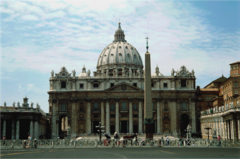
Façade of St. Peter’s Basilica, Rome. 1606—12.
Baroque.
Carlo Maderno. Italian.
Façade of St. Peter’s Basilica, Rome. 1606—12.
Baroque.

Façade of St. Peter’s Basilica, Rome. 1606—12.
Baroque.
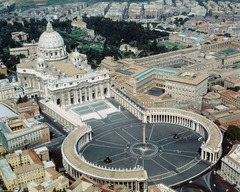
Colonnade of St. Peter’s, 1656—67.
Baroque.

Colonnade of St. Peter’s, 1656—67.
Baroque.
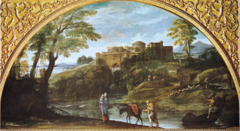
Landsacpe w/Fight into Egypt, 1603-04.
Baroque.
Doria Pamphili Gallery, Rome.
-new institution of Baroque, came to Rome from outside the city and took on comissions of a different style, more classical in nature, more like high renaissance art
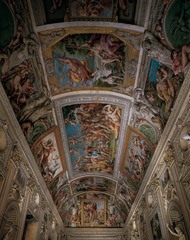
The Loves of the gods, Farnese Palace, Ceiling, 1597-1601.
Baroque.
-did a ceiling based on the stories of the classical past, similar to Bernin’s Apollo’s and Daphne’s
-filled with a series of the loves of Gods for mortals
-come from Avid, as the original source, all viewed as a parallel for Christian love (God’s love for his people)
-Neoplatinism importance of converging classical though with Christian ideas
-Christians of the Renaissance did not want to lose Classical literature
-constant attempt form the Renaissance to reconcile Pagan anitquity with Christian ideas
-keeping classical past alive and relveant
-stories of the loves of the gods, scene as the loveof God for his followers
-each is arranged to show one of those stories, architectural frame works, overlappign of forms, large nudes
-influence from the Sistine Chapel ceilling
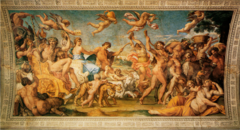
Triumphal Procession of Bacchus & Ariadne, Farnese Palace, Ceiling, 1597-1601.
Baroque.-Carracci’s center panel, Bacchus comes with his entourage to rescue Ariadne on the isle of Thosos
-Not like Carvaggio, which are strongly light and dark full of chiaruscuro
-very evenly lit (related to high renaissance interest)
-style: figures are heroic, similar to high renaissance
-Baroque classicsm
-Carvaggio : Baroque naturalism
-in both cases the art was produced in reaction to Mannerism (IT HAD TO GO)
-we already saw this story in an early Titian picture form High Renaissance in Venice
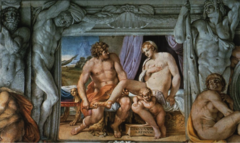
Venus & Anchises, Farnese Palace, Ceiling, 1597-1601.
Baroque.
-VENUS
-intended origninally for the sculpture glallery of the family
-looks a lot like Michelangelo
-colleciton of sculpture they had would have been on the floor-relates to Trojean war
-Baroque classicism
-different layes, architecture surrounding carry,
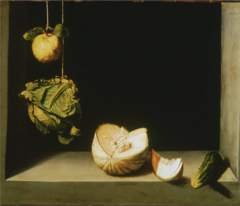
Still Life with Vegetables, 1628.
Baroque.
-active baroque, styleof art in Spanish Baroque school
-right around same time as earliest Carvaggio pictures, uses storng diagonal light, chiaroscuro so vegetables hsow up very brightly agsinst dark background
-some vegetables ocme out into your space
-cucmber, illusionistic miracle comign into your space
-creates space in a little niche, lit on one side dark on one side
-light is comign from upper left, from infront of the picture slightly, high angle
-powerfullight, careful magnetic painting, captures the texture and color of these objects and shapes, and makes them appear almost surreal, more powerful than reality, begin to vibrate slightly
-presence you would not expect vegetables to have
-PICTURE OF VEGETABLES BUT SOME PERSON HAS ARRANGED THEM THIS WAY
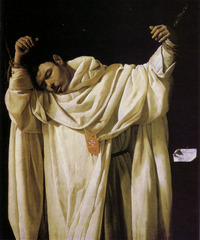
St. Serapion, 1628
Baroque.
-can see every fold in the fabric, filled with strong light and dark contrasts, most of the light on the surface, very dark background, pushes the image forward, dark backgrounds push the image froward into your space wants to impinge on your space (what baroque’s about)
-two become one in the same, high renaissance keeps you out, makes space as ideal as the image
-more naturalistic invites you in

The Water Carrier of Seville, 1619.
Baroque.
-unusual scenes, everyday life scenes, giotto scenes
-he is shown with a large waterjug on the surface of which you can see all of the lines on the jug caused by the wheel
-handing a glass of water to the little boy, in that glass of water there is a fig to refresh it
-light comes in diagonally, very interesting figure who like the jug is treated for his shape and formm
-as if the artist is trying to compare the two, a utilitarian useful and powerful figure like this massice jug of water
-very naturalistic, a representation of an everyday life scene (genre picture)
–
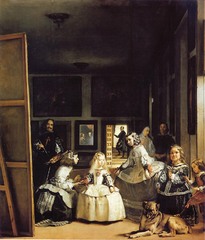
The Maids of Honor (Los Meninas), 1656.
Baroque.
-most famous picutre
-The Maids of Honor, gathering around the little princess,
-dog, other members of the royal court
-in the room where Diego is actually doing the painter
-painter standing in the background
-room is very deep, can see someone entering from open door,
Hanging on abckdoor, can see paintings of classical subjects having to do with art
-the mirror is reflecting the preence of the king and queen
-painting the king and the queen and daughter has come to visit and enetertain a they pose for Velasquez
-King and Queen are standing where you are
-OPEN COMPOSITION breaks space of viewer and space of the picture, invites you in, unlike high renaissance
-Baroque art is a very painterly style, allow the burshstrokes to show, interested in the pint, want you to understand this
Do not [aint glassy smooth surfaces in renaissance or mannerist
-create texture, but when close, can see storke of paint “painterly”
-chiorosco
Renaissance, interested in edges and outlines, can see silhouettes very clearly (linear style)
Baroque is more patinerly
King and Queen reflected in mirror, dark reflection form mirrors of the error
Comes from Arnofini Wedding Portrait (lived in town where that was hanging) hanging in the palace, saw this picture everyday
Just a little guy
Uses mirror to reflect people
Van Eyk’s is a linear picture, linear style, outlines are distinct, Baroque style edges are obscured lots of areas of deep dark style
Very different [atinerly style
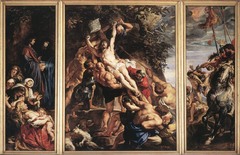
The Raising of the Cross. 1610.
Baroque.
-one of his earlier pictures, done for Antwerp Catherdral
-Christ on strong diagonal across the picture, illusion of space not thourgh linear perspective, but rather space in the baroque period is indicated through a strong diagonal, beam of the cross follows the broad shoulders of this tormentor up the body of Christ, head is further away than feet
-Baroque creates space using DIAgONAL RECESSion
–
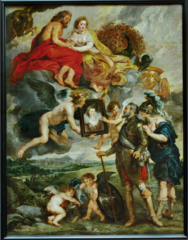
King Henry IVth Receives the Portrait of Marie de Medici, 1621—25.
Baroque.
-series of GIANT pictures, showed her life with Henry as an aspect of propaganda of her relationship
-Henry the Fourht falling in love with the portrait of Marie de Medici
-Marie de Medici is being held by cupid and the goddess of Mary
Jupiter and Juno, hover above in the heavens, Henry does not have a chance
Personification of the nature of France, whispers in her ear, yes she is the one
-couple of putti
-very painterly, can see the movement of the brushstokres, highlights on the surface of the bared
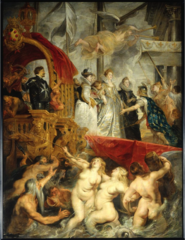
Marie de Medici Arrives at Marsailles, 1621—25.
Baroque.
-lots of classical refernces, born to shore by myriads and tritons of the sae blowing trumpets, Marie de Medici desembarks ready to wed, greeted by personification of France
-allegory
-so big he could not paint themselves turns design over to his owrkshop, provides and oil sketch of the compisiton
-this is the finish product is the product of a laong process, Rubens would ocme in and make changes
-“overpainted by Rubens”

Madonna of the Long Neck, 1534-40.
Mannerist.
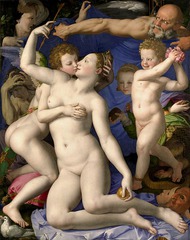
Venus, Cupid, Folly and Time, .ca. 1546
Mannerist
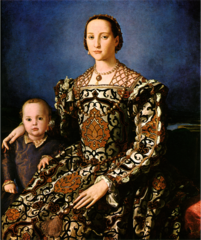
Portrait of Eleanora of Toledo and her Son, 1546.
Mannerist.





